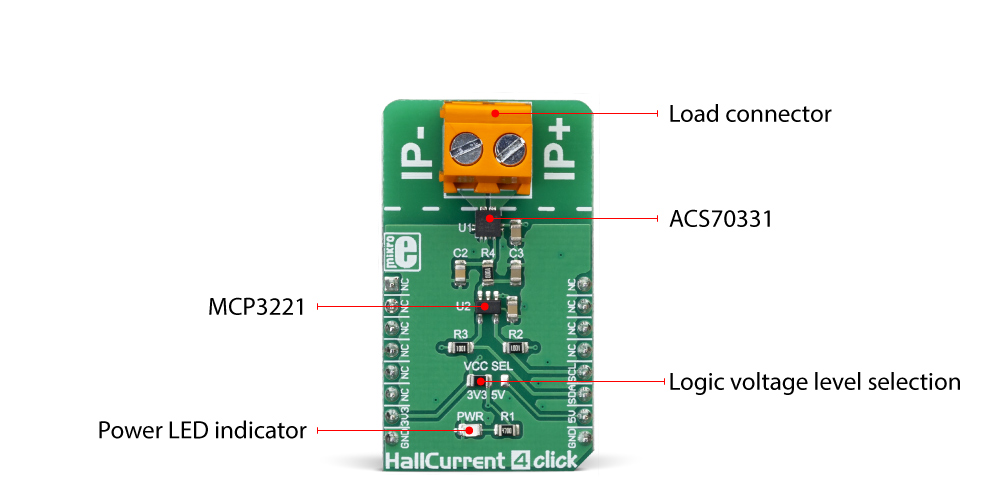MikroElektronika
Hall Current 4 Click
Hall Current 4 Click
SKU:MIKROE-3308
Out of stock
Couldn't load pickup availability
Share

DO NOT TOUCH THE BOARD WHILE THE EXTERNAL POWER SUPPLY IS ON!
Note: Voltage higher than 50V can be hazardous! The click is to be used by trained personnel only and attention when applying high voltage is strongly adviced.
Due to the fact that the sensor provides a solely analog voltage at its output which is linearly commensurate to the current through the load connected to the output terminal, the Hall Current 4 click also has the integrated analog-digital converter which serves to transform the output voltage from the ACS70331 to digital value. The digital value is possible to read from the I2C interface.
How does it work?
The Hall Current 4 click uses the ACS70331 current sensor produced by Allegro, and the 12-bit ADC marked MCP3221, produced by Microchip. The ACS70331 uses GMR elements to indirectly measure the current flowing through the primary conductor of the IC, by sensing the field produced by this current. This IC utilizes the fact that the field generated by the current passing through the primary conductor affects the voltage across the GMR sensor. The GMR sensor voltage cahnges even with a very low field strength, which makes the ACS70331 very suitable for accurate measurements of lower currents. However, the saturation happens quite soon after, making it unsuitable for higher currents. The ACS70331 has the sensitivity of 200 mV/A and can measure the current in the range range from -5A to +5A

Considering that the operative range of the ACS70331 is approximately 1 MHz, the variations of the output voltage with the load current are quite fast with no latency. The output voltage from the ACS70331 is fed to the input of the analog-digital converter (ADC) which which allows reading the conversion data via the I2C interface. The ACS70331 has a small primary conductor resistance of 1.1 m?, resulting in low power dissipation and consequently low temperature rise due to current flow through the sensor.
The sensor has no physical contact with the output pins on the chip as it operates exclusively by the principle of the filed generated by the current which runs through the input pins (primary conductor). The load voltage at the input pins is isolated from the rest of the chip. However, it is not safe to use at the voltages higher than 100V.
Specifications
| Type | Current sensor |
| Applications | Hall Current 4 click is perfect for various applications designed for current sensing, e.g. monitoring the current in battery chargers, or for the various kinds of system power supplies, etc. |
| On-board modules | IC ACS70331, high sensitivity GMR-based current sensor IC, by Allegro |
| Key Features | Very low serial resistance, measurement of relatively high voltage values – up to 5A independent from the polarization, great accuracy thanks to the GSR current sensor, big range of power supply voltages to which the load can be amounted, etc. |
| Interface | I2C |
| Input Voltage | 3.3V,5V |
| Click board size | M (42.9 x 25.4 mm) |
Pinout diagram
This table shows how the pinout on the Hall Current 4 Click corresponds to the pinout on the mikroBUS™ socket (the latter shown in the two middle columns).
Onboard settings and indicators
| Label | Name | Default | Description |
|---|---|---|---|
| VCC SEL | VCC SEL | Left | Logic voltage level selection: left position 3.3V, right position 5V |
| PWR | PWR | - | Power LED indicator |
Hall Current 4 click electrical specifications
| Description | Min | Typ | Max | Unit |
|---|---|---|---|---|
| Current range | -5 | - | +5 | A |
| Allowed voltage across the input terminal | 0 | - | 100 | V |
Software support
We provide a library for the Hall Current 4 Click on our LibStock page, as well as a demo application (example), developed using MikroElektronika compilers. The demo can run on all the main MikroElektronika development boards.
Library Description
This library provides basic functionality for reading the current value and controlling the click board.
Key functions:
-
float hallcurrent4_getCurrent()- Reads current in mA. -
uint16_t hallcurrent4_readData()- Reads current 12bit data.
Examples description
The application is composed of the three sections :
- System Initialization - Initializes I2C module.
- Application Initialization - Initializations driver init.
- Application Task - (code snippet) - Reads Current value in mA and logs this data to USBUART every 1 sec.
void applicationTask()
{
char demoText[ 50 ];
float Current;
Current = hallcurrent4_getCurrent();
mikrobus_logWrite(" Current value: ", _LOG_TEXT);
FloatToStr(Current, demoText);
mikrobus_logWrite(demoText, _LOG_TEXT);
mikrobus_logWrite(" mA", _LOG_LINE);
mikrobus_logWrite(" ------------------------- ", _LOG_LINE );
Delay_ms( 1000 );
}
The full application code, and ready to use projects can be found on our LibStock page.
Other mikroE Libraries used in the example:
I2CUART
Additional notes and information
Depending on the development board you are using, you may need USB UART click, USB UART 2 click or RS232 click to connect to your PC, for development systems with no UART to USB interface available on the board. The terminal available in all MikroElektronika compilers, or any other terminal application of your choice, can be used to read the message.
mikroSDK
This click board is supported with mikroSDK - MikroElektronika Software Development Kit. To ensure proper operation of mikroSDK compliant click board demo applications, mikroSDK should be downloaded from the LibStock and installed for the compiler you are using.




New Products
-
The AI bundle - Crazyflie 2.1 Brushless
Vendor:BitcrazeRegular price Rs. 91,296.00Regular priceUnit price / per -
Getting started - Crazyflie 2.1 Brushless
Vendor:BitcrazeRegular price Rs. 57,798.00Regular priceUnit price / per -
Holybro SiK Telemetry Radio V3 915MHz 100mW
Vendor:HolybroRegular price Rs. 5,599.00Regular priceUnit price / per -
 Sold out
Sold outAloha Solo
Vendor:Trossen RoboticsRegular price Rs. 1,200,000.00Regular priceUnit price / per -
 Sold out
Sold outPixhawk 6C Mini + PM02 + M10 GPS
Vendor:HolybroRegular price Rs. 18,699.00Regular priceUnit price / perRs. 19,500.00Sale price Rs. 18,699.00Sold out -
 Sold out
Sold outPixhawk 6C Mini + PM06 + M9N GPS
Vendor:HolybroRegular price Rs. 20,499.00Regular priceUnit price / perRs. 22,000.00Sale price Rs. 20,499.00Sold out -

 Sold out
Sold outHolybro Pixhawk 6C Mini - Model A
Vendor:HolybroRegular price Rs. 21,999.00Regular priceUnit price / per -

 Sold out
Sold outHolybro PM06D Power Module (14S)
Vendor:HolybroRegular price Rs. 3,549.00Regular priceUnit price / per -

 Sold out
Sold outPM06 V2 Power Module
Vendor:HolybroRegular price Rs. 3,349.00Regular priceUnit price / per -
Pixhawk 6C (plastic), PM02, M10 GPS
Vendor:HolybroRegular price Rs. 30,999.00Regular priceUnit price / perRs. 42,999.00Sale price Rs. 30,999.00Sale -
Micro M10 GPS
Vendor:HolybroRegular price Rs. 3,199.00Regular priceUnit price / per -
SiK Telemetry Radio V3(500mW 433MHz)
Vendor:HolybroRegular price Rs. 6,499.00Regular priceUnit price / per -
SiK Telemetry Radio V3(100mW 433MHz)
Vendor:HolybroRegular price Rs. 6,499.00Regular priceUnit price / per -
 Sale
SalePixhawk 6C(Plastic)
Vendor:HolybroRegular price Rs. 22,499.00Regular priceUnit price / perRs. 26,249.00Sale price Rs. 22,499.00Sale -
X650 Frame Kit
Vendor:HolybroRegular price Rs. 36,199.00Regular priceUnit price / per -
Pixhawk 6X (ICM-45686) Standard v2A(M10 GPS,PM02D)
Vendor:HolybroRegular price Rs. 56,599.00Regular priceUnit price / per -
H-Flow (Optical Flow and Distance Sensor Module)
Vendor:HolybroRegular price Rs. 14,849.00Regular priceUnit price / per -
Pixhawk 6X Pro FC
Vendor:HolybroRegular price Rs. 61,699.00Regular priceUnit price / per -
Pixhawk 6X (ICM-45686) FC
Vendor:HolybroRegular price Rs. 15,999.00Regular priceUnit price / per -
Pixhawk Jetson Baseboard
Vendor:HolybroRegular price Rs. 44,999.00Regular priceUnit price / per -
EZO-HUM™ Embedded Humidity Probe – Plastic Body
Vendor:Atlas ScientificRegular price Rs. 6,049.00Regular priceUnit price / per -
EZO Complete-Dissolved Oxygen™
Vendor:Atlas ScientificRegular price Rs. 14,799.00Regular priceUnit price / per -
EZO-O2™ Embedded Oxygen Sensor – Plastic Body
Vendor:Atlas ScientificRegular price Rs. 10,999.00Regular priceUnit price / per -

 Sold out
Sold outCrazyflie 2.1 Brushless
Vendor:BitcrazeRegular price Rs. 53,399.00Regular priceUnit price / per -
Propeller 47-17 (4CCW+4CW) (black)
Vendor:BitcrazeRegular price Rs. 699.00Regular priceUnit price / per










































